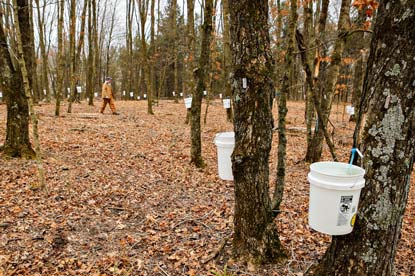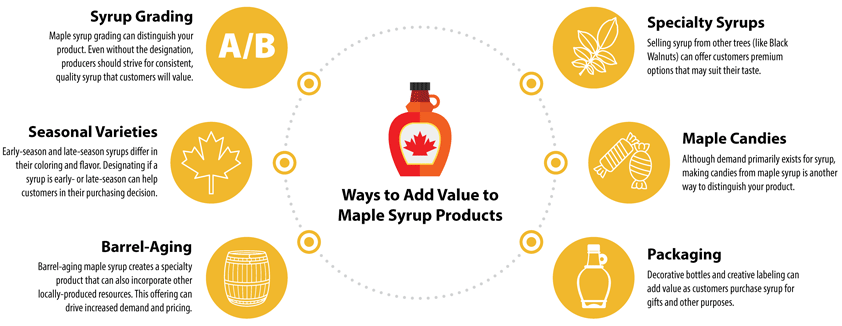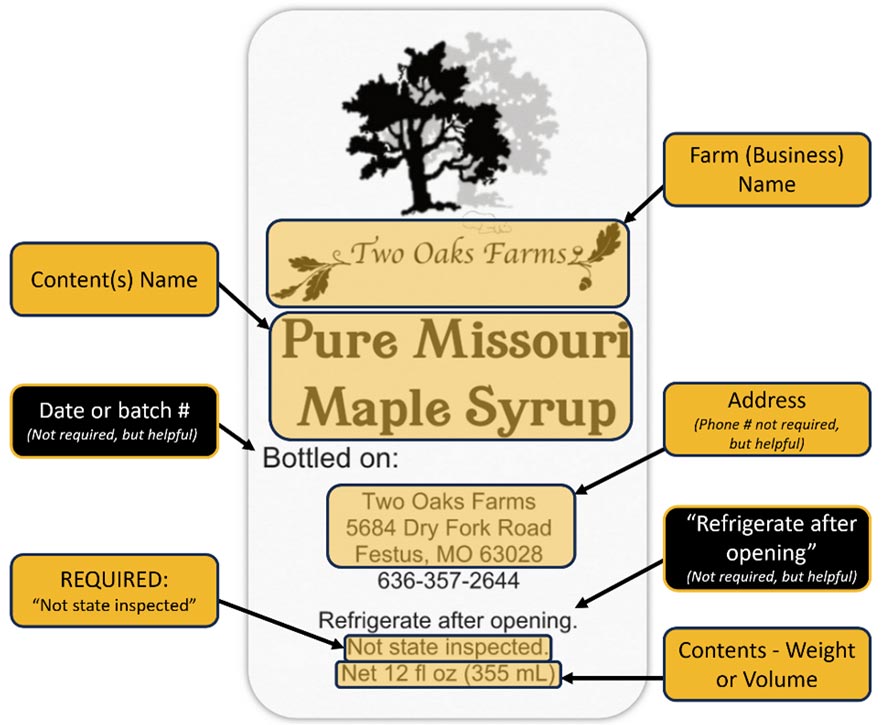
An abundant supply of maple trees in the Midwest, particularly sugar maples, gives Missourians the opportunity to tap into a local treat: homemade syrup. While maple trees are the focus for most syrup producers, other trees such as walnuts can also be tapped. The popularity of tree sugaring, the art of tapping and processing tree sap into syrup, is growing in the lower Midwest as seen in the increasing popularity of social platforms dedicated to sugaring such as the Missouri Maple Syrup Facebook page1. This growth was also documented in the 2022 survey of syrup producers in this region (PDF). Missouri respondents produced 480 gallons of syrup that year, significantly more than the 333 gallons reported in the 2017 Census of Agriculture.
The 2022 survey found that one in four respondents sold syrup that year or the prior season, while others made smaller amounts for family, friends, or gifting. However, most producers had either sold syrup at some point or had an interest in sales (57%). Tree sugaring is a tasty hobby for many, but it can also provide income for those interested in supplementing their earnings or making it part of a land-based business.
This guide aims to assist existing and new tree-sugaring enthusiasts with an interest in selling locally-made syrup by covering the basics of product marketing. The guide is structured around four marketing principles: product, pricing, place and promotion.
Product
Locally produced syrup is in high demand as interviewed producers reported quickly selling out of their syrup in 2022 and in prior years. While other products can be made from tree sugaring, such as candies, syrup is almost exclusively what producers sell. Missouri maple syrup also fetches a premium price. For example, pints of maple syrup in several Midwestern states sold for less than $10 in 2020–21, whereas average Missouri pints sold for $15 in 2022. A few producers noted that they receive consistent feedback from customers that “notes of vanilla and butterscotch” enhanced and distinguished the product from commercially available maple syrup produced in the northeast.
Apart from flavor, consumers value “made in Missouri” syrup for a variety of reasons. Having a personal connection to the producer and their story — often through conversations at the farm stand or farmers market — is valued. Supporting local entrepreneurs is also an important reason for many consumers. “Farm-to-table” and “Slow Food” movements, which promote locally grown food, traditions, and small businesses, have also raised consumer awareness of the benefits of supporting food producers in their surrounding communities.
Distinguishing products through quality, aging, type of syrup, and packaging
There are several ways to add value to maple syrup products beyond the premium “made in Missouri” label (Figure 2).

Syrup grading
Grading is a voluntary step that can add value to your product. Official U.S. grades, established by the U.S. Department of Agriculture (USDA), designate different levels of quality and are designed to facilitate orderly marketing by providing a convenient basis for establishing quality.

Maple syrup can achieve the Grade A designation, the highest quality level, if it has the following characteristics:
- The solids content is between 66% and 68.9% by weight (in Brix units measured by a hydrometer or refractometer);
- Has good uniform color;
- Has good flavor and odor, with the intensity of flavor normally associated with the color class (Figure 3);
- Is free from off flavors and odors considered as damage; and
- Is free from cloudiness, turbidity and sediment; and is clean.
Maple syrup grading is optional and currently self-assessed but having that level of quality can distinguish your product. Even without the designation, producers should strive for consistent, quality syrup that customers will value.
Early and late season varieties
Early-season syrup, lighter in color and more subtle in flavoring, is associated with sap gathered in early winter. Consumers may prefer this golden, delicate-flavored syrup for pancakes and waffles. Darker, late-season syrup has a stronger flavor that some customers prefer, especially for cooking. For example, a thicker, late-season syrup can be used as a glaze or in marinades.
Barrel-aging
Barrel-aged maple syrup is a specialty product that drives increased demand and pricing. With Missouri’s growing craft spirits and barreling interest, bourbon aging adds to the “made in Missouri” story as barrels can be purchased from local distillers. Fifteen-gallon barrels, used to age whiskey in less time than the typical 53-gallon barrel, are used by some distillers and offer one option for syrup aging. Smaller, new barrels can also be used.
Specialty syrups
Syrup from Maples (Acer spp.) is the most common offering of tree sugaring producers, but most surveyed respondents (65%) tapped other trees as well. Selling syrup from different trees can offer customers premium options that may suit their taste. For example, Black Walnut (Juglans Nigra) syrup can sell for several dollars an ounce. Walnut sap, however, requires greater temperature variation than maple sap to flow and isn’t as sugar rich — requiring closer to 60 gallons, rather than 40, to produce a gallon of syrup.
Maple candies
Making candies from maple syrup is another way to distinguish your product. Demand for syrup was strong enough that no producers reported selling other products, such as caramels or sugar, in 2022.
Packaging
Creative labeling and bottling can quickly add value as customers purchase syrup for themselves or as gifts for others. Attractive labeling can serve many purposes — tell the producer’s Missouri story, provide contact information, and promote reuse for further marketing. Decorative bottles will also enhance the value to consumers as the product can easily serve as a gift item.
Producers can sell their products at higher prices when their syrup is distinguished in one or more of these ways, but costs can also rise, especially with packaging and aging. It is important to compare different packaging or processing options to ensure that the increased pricing, coupled with consumer demand, is sufficient to cover the additional cost.
Pricing
Pricing is influenced by demand for the syrup, which has been strong, but also by how the product is distinguished and where it is sold. If perceived as a common item competing with grocery store brands, then the price of syrup would fall below $0.50 per ounce. However, “made in Missouri” syrup has product distinction so pricing from $1 to $3 per ounce is common.
Missouri syrup typically sold for $1.14 per ounce in 2022. The size of the syrup bottle influenced the price as larger quantities often sold for a lower average price per ounce (Table 1).
Table 1. Average syrup price from online sources, 2022.
| Bottle size (ounces) |
Average price | Price per ounce |
|---|---|---|
| 8 | $10.50 | $1.31 |
| 12 | $13.00 | $1.08 |
| 16 | $15.00 | $0.94 |
| 32 | $24.00 | $0.75 |
| Table 1 data sourced from the Missouri Maple Syrup Facebook page, Facebook Marketplace, and various online retailers. | ||
Comparative retail pricing information for smaller bottle sizes is limited, but it appears that Missouri producers are receiving premium prices for their syrup. USDA data for 2021 show that a pint (16-ounce) bottle of syrup in Wisconsin and Michigan sold for $9.60 and $8.80, respectively. A 2020 Indiana survey indicated a retail price of $8.39 per pint of maple syrup. These prices, while a year or two older, compared to $15 for Missouri producers in 2022.
The premium price enjoyed by Missouri producers likely reflects both a market for locally produced syrup and the relative scarcity of this product. Syrup production is much larger in the other states noted, which drives down prices. The higher prices for Missouri-produced syrup will likely continue due to the state’s relatively smaller output and product demand. Some producers limit customers to 32 ounces per customer, for example, to satisfy the large demand.
Place
Two out of three (68%) Missouri syrup producers preferred to sell their products directly from the farm or at farmers markets. Online sales interested 42% of survey respondents, followed by one in four (26%) with interest in retail/wholesale markets. Selling directly from the farm is the easiest way to start making income, especially with a smaller operation. However, growing your sales will likely mean branching out to other markets where you can reach a broader range of customers.
Direct farm sales and agritourism
Selling directly from your farm or residence is a low-cost way to start generating revenue. A visible location near larger cities or highways can help broaden your market, as nearby residents or travelers can more easily find you. Several producers noted that farm visits were the main avenue for the bulk of their maple syrup sales.
Bringing visitors to the farm can be a way to add value to the experience of purchasing a premium locally made product. A farm may have other products to sell, giving customers additional reasons to stop by, and some operators see the visit as an opportunity to educate and entertain consumers on how a farm operates — called agritourism.
Agritourism — attracting visitors for entertainment/education purposes related to farm operations — is a broader business strategy that can take many forms: participation in or demonstrations of the syrup operations, tastings, venues, etc. Two of the three respondents with large operations attributed over 75% of their maple syrup sales to agritourism services.
Farmers markets
Selling directly from the farm has advantages, but locations with little highway visibility and smaller surrounding populations can limit the size of your market. Bringing your syrup to a farmers market offers an alternative to broaden your sales while directly interacting with customers.
Farmers markets let you build familiarity with a consistent customer base which can ensure repeat business. A few producers noted that farmers markets are like their “own kind of marketing” — enabling them to showcase their product to potential customers.
Price, driving distance, and duration of sales are the main factors to consider in selecting which farmers market to attend. Price, both what customers are willing to spend on the product and the cost of the stall rental and fuel to reach the market, will greatly impact profitability.
Several producers noted that sales are higher at farmers markets located near large metropolitan areas. With a high price point, smaller markets in rural areas may not generate the same level of demand as the larger, more urban, farmers markets. Another consideration is that smaller markets can occasionally limit specialty producers — honey and maple syrup, for example — to only one vendor per market day to not divide sales.
Given the short production window for maple syrup and its high demand, selecting a market that allows for weekly booth rentals can afford producers more flexibility in offering their product. Some markets require longer commitments from producers to be able to sell their products which could present a problem if the maple syrup on offer is only available for a few weeks each year. For producers with other locally grown or crafted items to sell, maple syrup can be just one of multiple farmers market offerings.
Online sales
Online sales offer another option for syrup producers, but generally as a complement to other marketplaces. Several producers noted that while online sales were available for their customers, the primary source of sales was direct-to-consumer — either through their farm or a local farmers market. For example, customers can order syrup online for pickup at the farmers market or the farm.
Several producers host sales platforms on their own personal websites, whereas others utilize Facebook for sales. An online presence is a cost-effective way to advertise your products, even if you only sell syrup directly. For online sales, you will need to consider e-commerce tools for accepting payments along with the added costs of packaging and shipping products.
Retail/Wholesale markets
Selling syrup at a farm stand or farmers market is typical, but there is interest from retailers in selling Missouri syrup at their store locations. Some smaller retailers that specialize in locally made products desire Missouri syrup for gift baskets, for example. Selling syrup wholesale to retailers can offer more stable, larger markets but introduces additional cost and profit considerations.
Several producers noted that they have been approached by a large grocer to sell commercially but none took the opportunity due to the high cost of gaining access to a regulated commercial kitchen, either through building their own or renting space. A regulated and inspected commercial kitchen is required to sell maple syrup to retailers. Retailers can also demand a lower price point, requiring the producer to be highly efficient and large enough to justify the reduced profit levels.
Promotion
Producers have many outlets to advertise their syrup. All surveyed producers advertised their syrup through word-of-mouth, a cost-effective way to promote sales in smaller markets. Eight out of ten also used social media sites like Facebook. Websites were used less frequently (20%), and no one used paid advertising.
Word-of-mouth
The number one method for promoting maple syrup cited by surveyed producers was word-of-mouth. Several producers noted that they did not market their product; relying on word-of-mouth alone to generate interest and sales. Many respondents noted that the bulk of their sales came from just a few groups of visitors — typically the parents and extended friends and families of school students, for example. Strong bonds between farmer and customer, which can be developed through farm visits and at farmers markets, are helpful in building trust that can form a durable network of repeat customers.
Social media
Facebook is a common social media platform to advertise products cost-effectively but is also a beneficial way to grow your support network of individuals with the same interest. Facebook enables you to interact with customers through its messaging service to answer questions or make sales. Facebook also offers the opportunity to sell directly to customers by setting up a shop on your page. The Missouri Maple Syrup Facebook group, with over 1,500 members, offers a community of practice for new and emerging maple syrup producers to learn from one another.
Websites
Websites offer the broadest reach for marketing and online sales. The initial cost of setting up a website includes paying for the platform and site design. Maintaining the site involves time and ongoing costs for hosting the site. If online sales are desired, a producer must select a pay platform and determine how syrup will be delivered — at farmers market or shipped directly to the customer.
Given that the bulk of Missouri maple syrup sales are direct-to-consumer through on-farm sales, farmers markets, and word-of-mouth, most producers choose not to host online sales through a website.
Missouri Grown
Another way to promote your business is to join popular outreach platforms that make it easier for consumers to find you. Missouri Grown is an outreach program through the Missouri Department of Agriculture that promotes Missouri grown and Missouri-made items, representing food and non-food products, retailers, farmers markets, agritourism and agricultural experience destinations; their membership fee is $50 annually (as of 2023). Members gain access to the network of producers and can use the “Missouri Grown” label, among other benefits.
In addition to Missouri Grown, promoting your business with other networks, such as Slow Food communities, can raise awareness of your product to consumers who value locally grown, organic food products.
Special events
Special events are another way to directly interact with potential customers curious about maple syrup. The Missouri Department of Conservation (MDC) and other entities host maple syrup events, typically in late winter when the sap is flowing. Events include the MDC’s backyard maple sugaring event at Rockwoods Reservation in Wildwood, Missouri and the Maple Sugar Festival at Historic Daniel Boone Home in Defiance, Missouri.
Labeling
To legally sell maple syrup in Missouri several pieces of information must be included in the product label (Figure 4).
- Farm (Business) name
- Contents name
- Address
- Contents weight/volume
- “Not state inspected.”

“Not state inspected” is required language when selling syrup directly to consumers. If the syrup producer sells their product to another business for resale, their operation must be inspected and found to comply with Good Manufacturing Practices regulations, part of the Manufactured Food program administered by the Missouri Department of Health and Senior Services.
Other information can be included on the label to aid consumers in safely consuming the product after purchase such as:
- Date of production or batch number
- “Refrigerate after opening.”
Labels can often be purchased in bulk to reduce costs. Several online resources can help producers identify their product as “Missouri made” which can enable producers to offer their product for sale at a premium price.
Marketing principles revisited
Value-added agricultural producers who are interested in selling directly to consumers should consider the market for their product carefully. Four marketing principles: product, price, place and promotion are the fundamental components to building a marketing plan for a product. This guide is designed to aid maple and other tree syrup producers or entrepreneurs to improve or build their marketing efforts. Missouri’s tree syrup industry shows recent growth and strong prices within the state suggest the industry can continue to expand.
References
Access the full 2022 producer survey results by viewing the Putting Maple on the MAP in the Lower Midwest report (PDF).
1. The Missouri Maple Syrup Facebook site has grown from 1,300 members in late 2022 to over 1,600 by the fall of 2023.
Funding for this publication was made possible by the U.S. Department of Agriculture’s (USDA) Agricultural Marketing Service through grant 21ACERMO1005-00. Its contents are solely the responsibility of the authors and do not necessarily represent the official views of the USDA.